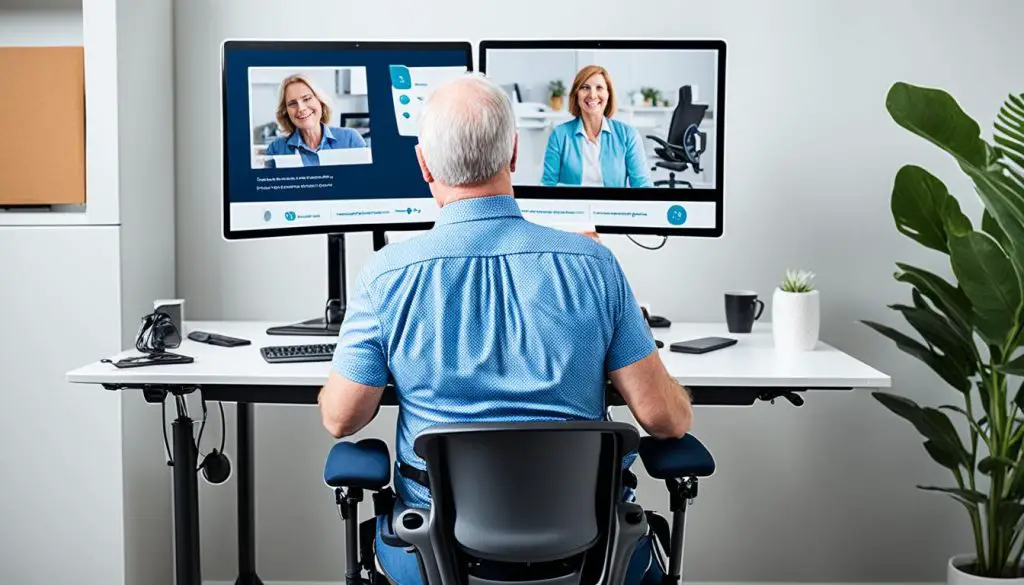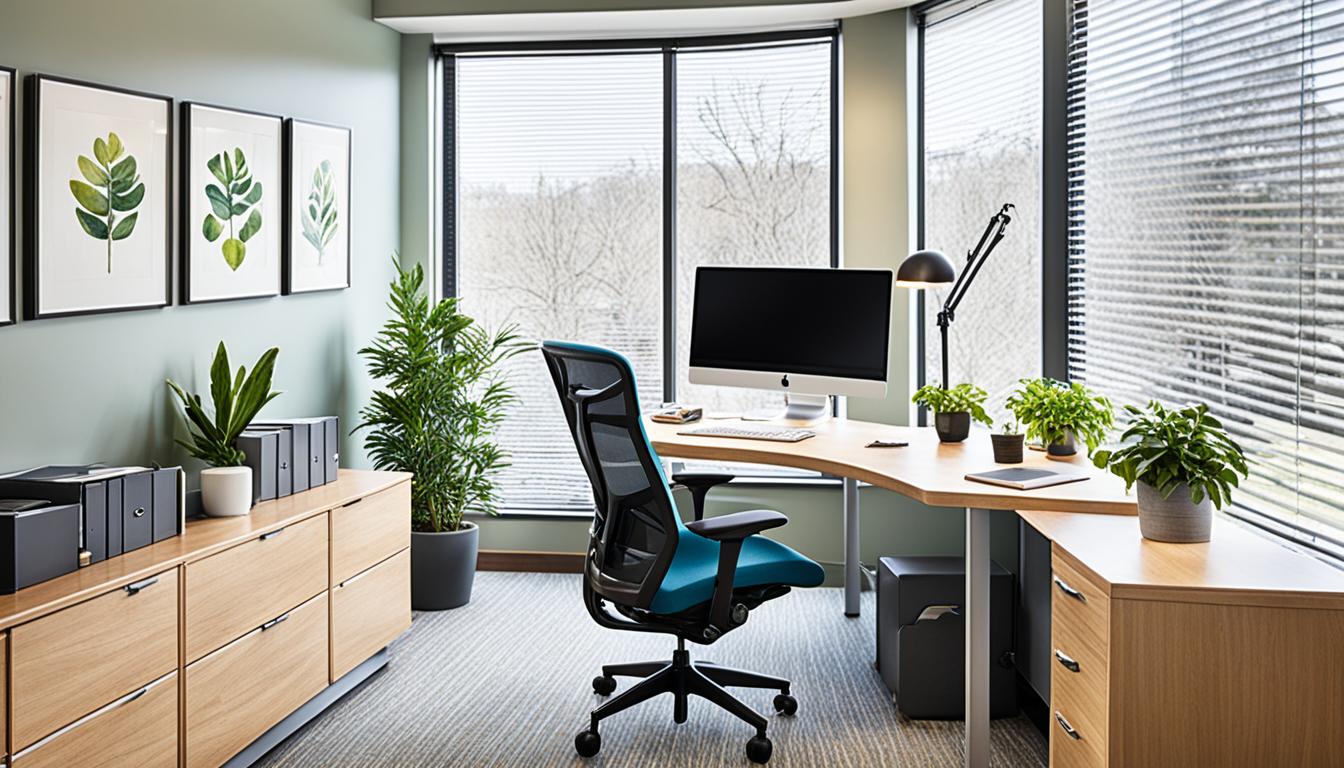Living with fibromyalgia, chronic pain, and migraines made me rethink my home and work spaces.1 I’ll share how I created a space that helps me manage my health and stay productive.
Imagine your desk area could actually make dealing with your health condition easier. Good design makes your office a healing place. It lessens stress, limits sensory overload, and fosters a restful place.
I chose furniture and tools that ease my body and mind. I control light and sound to cut sensory issues.1 When you have a chronic illness, your home needs to be extra cozy. Making it support your health saves your strength and lets you stay in charge.
Introduction to Chronic Illness and Its Impact
Chronic illnesses can turn a person’s life upside down, affecting their body, mind, and social life in a negative, long-lasting way.2 People with conditions like fibromyalgia, chronic pain, migraines, and depression feel severe symptoms such as pain, tiredness, and reacting strongly to light and sound.2 This can make moving around hard and enjoying activities they love nearly impossible.2 It’s important to live in a place that meets these needs to feel some comfort and control.
What Is Chronic Illness?
Chronic illnesses last a long time and need constant care, affecting how someone lives every day.2 Examples include arthritis, cancer, diabetes, and heart problems.2 People affected must adjust their life to manage symptoms and keep well.
These conditions can stay for months or years, making life very different.2 Living situations and lifestyle might need to change to cope with these illnesses.
Debilitating Symptoms and Challenges
Chronic illnesses bring on many issues for the body, emotions, and social life.2 Chronic pain can be a major problem, affecting how a person can move, work, or simply live their life.2 Things like fibromyalgia, osteoarthritis, and back pain bring constant tiredness and pain, making daily tasks a big challenge.2 Also, the mental effects such as depression and anxiety add to the hardship.
The Importance of a Supportive Environment
Addressing chronic illness needs to look at many wellness factors together.2 It’s not just physical health but also mental, social, spiritual, and financial well-being that can be affected.2 A supportive home makes it easier to handle symptoms and keeps a sense of comfort and independence.2 This kind of space focuses on making life easier, more comfortable, and healthy for those with chronic illness.
The Role of Interior Design in Chronic Illness Management
Recent studies show that smart interior design helps those with chronic illnesses. Biophilic designs, which include nature, make living spaces feel healing. Elements like calming colors and natural light improve physical and emotional health.3 Designers create homes that support individual needs, especially for chronic illness care.
For those with chronic illnesses, changing the home’s design can be better than moving. Making a home pain-friendly is key, including installing assistive tools.3 Adding natural elements indoors boosts mental health and well-being for those living with chronic diseases.3
Designing for dementia or Alzheimer’s involves more than just safety. Early on, security features help. But later, adapting environments to aid memory and cognition is crucial.3 Choosing eco-friendly materials for design supports cleaner air indoors. They reduce harmful emissions and help people stay healthy. Following green building standards is essential for design that’s good for the planet.4
Poor indoor air can cause serious health issues over time. It shows why designing for healthy living is vital.4 Through education and training, the design industry works to create spaces that are good for both people and the planet.4
Ergonomic and Accessible Workspace Design
For those with chronic illnesses, a well-designed home office is key. It helps in easing physical symptoms and staying productive. Adjustable furniture is a must. Desks and chairs should be able to change heights. This makes it easy to set up a work spot that’s right for the body.5 Good lighting control is also important. It should let you change brightness and reduce glares. This can lessen headaches and keep eyes from tiring.5 Thinking about the placement of your desk and chair, like having back and wrist support, matters too. It helps cut physical tiredness and aches when you’re working for a long time.5
Adjustable Furniture and Lighting
Making your home office workspace adjustable is a game-changer for those with health challenges. You can choose desks and chairs that move. Plus, add things like dimmers and curtains that block light. These choices let users set up their workspace in a way that’s best for their health. It reduces stress on the body and the senses.5
Optimized Desk and Chair Setup
Choosing the right desk and chair is vital. Look for options with lumbar support and wrist rests. This cuts down on how tired and sore your body feels over long days.5 Creating a work area that supports good posture and comfort helps dodge injuries and pain. It’s a smart move for working safely and being productive.5
Reducing Physical Strain and Fatigue
Using ergonomic design in your home office can lower physical stress and fight off tiredness.5 Features like movable furniture, good lighting, and a well-thought desk and chair are our allies. They help make a workspace fit for anyone with a health issue. This way, you can keep up a good work pace without sacrificing comfort.5
Pain Management Through Design
Living with chronic pain can be tough, but the look and feel of our home can really help. Using calm colors and natural textures like wood and stone can make us feel better.3 Having plants and sunlight in our home office brings peace. These design choices can lessen our pain, making us feel better overall.
Therapeutic Colors and Textures
Using color and texture the right way can reduce pain. Soft colors like blues, greens, and soft materials like wood help calm us. They create a space that’s good for dealing with pain and stress.
Integrating Natural Elements
Adding nature to our office can really make a difference for chronic pain. Plants, water features, and lots of light can bring peace and well-being. This approach turns our space into a calming one that supports both our body and mind. It fights the negative effects of ongoing pain.

Mitigating Sensory Overload and Fatigue
Chronic illnesses such as fibromyalgia and migraines can make us more sensitive to things like bright lights and loud noises. This leads to severe symptoms and fatigue.6 We can lessen glare and overstimulation by using things like dimmers, blackout curtains, and specific task lights.6 Also, a peaceful setting with soundproofing and noise-reducing materials can reduce bothersome sounds.6 These strategies, along with sensory overload and fatigue management features, help in creating a workplace at home. Such a setup aids in coping with sensitivity issues and staying focused and productive.
Lighting Control and Glare Reduction
For those whose chronic conditions make them sensitive to bright or harsh light, managing lighting well is key. You can adjust lighting with dimmers, use blackout curtains, and employ specific task lights to cut down on glare.6 By adjusting the light, you can reduce symptoms like migraines and eye strain. This allows for better and more comfortable work.
Sound Insulation and Noise Minimization
Just as with lighting, reducing bothersome sounds is essential for a suitable home office. Adding sound insulation and noise-reducing materials makes the area quieter and more relaxing.6 This is very helpful for those with illnesses like fibromyalgia or migraines. They are particularly sensitive to noise, which can make their symptoms worse.
Chronic Illness Home Office Design Comfort
Home office design is crucial for those with chronic illnesses. It’s not just about function and therapy. It’s key to make it comfortable and show off what you love.7 Use furniture that can change and set up areas for different activities. This lets people make their space just right for them.7 Adding things that make you happy, like art or photos, is also important. They can make your office feel warm and personal.
Customizable and Adaptable Spaces
For those struggling with chronic illnesses, a workspace that can change is vital. Adjustable furniture and areas for different tasks are important. They let you adjust your office to fit your health needs.7 This way, your work area can be a place of peace. It should help you feel better in body and mind.
Incorporating Personal Interests and Hobbies
Including what you love in your office can do wonders for how you feel. It could be hanging up art or creating a special corner for your hobbies. This turns your work area into a place that really feels like yours.7 Not only does it make your office look nicer, but it can also help you feel calmer, less stressed, and more ready to take on the day.
Biophilic Design for Mental Well-being
Biophilic design is about bringing nature’s features into our living spaces. It has a big impact on our well-being and mental health.8 Adding plants, water elements, and views of nature at home helps people with ongoing health issues feel calm, restored, and connected to the natural world.
Incorporating Nature into the Home Office
Adding plants, natural textures, and letting sunlight in through the window can really boost our mood. It especially helps those dealing with chronic illnesses feel better.8 These natural touches make a space relaxing. They lower stress and make us feel more connected to the outside.
Benefits of Natural Light and Ventilation
Having lots of natural light and good air flow in your office is also key. It can perk up your mood and help you focus better.8 Plus, it helps your body’s internal clock work well and aids in healing. These steps are super important for folks with long-term health issues.
Adaptive Technology and Assistive Devices
Adding adaptive technology and assistive devices to a home office can make a big difference for those with long-term illnesses.9 About half of those with disabilities use special tech made for them,9 while over 4.5 million use canes, walkers, and wheelchairs.9 Tools like voice-controlled lights and smart speakers cut back on the effort needed to use things around the house.
Voice-Controlled Smart Home Features
Voice-controlled smart home tools help keep people productive and self-reliant, even with health challenges.9 76% of kids with these gadgets can stay in regular classes,9 and 62% of adults reduce how much they rely on others.9 These technologies make it easier to handle daily tasks, lowering the stress of chronic conditions.
Ergonomic Input Devices and Software
Items like speech-to-text software, touchpads, and special keyboards make using a computer easier and more comfortable.9 92% of working people say assistive tech makes them more efficient,9 while 83% note it helps them make more money.9 Using these technologies wisely boosts productivity and freedom for those with lasting health issues.

Creating a Relaxing and Rejuvenating Environment
Designing a home office that relaxes and rejuvenates is key for people with chronic illnesses. Using color psychology to choose calming colors can greatly improve mood and well-being.
Soft blues, greens, and earth tones turn your office into a calming place. They lessen stress, reduce anxiety, and help you focus better.10
Incorporating Relaxation Spaces and Nooks
Creating special areas for relaxation, like reading nooks or meditation spots, allows for much-needed self-care. These spaces should have soft furniture, natural elements, and gentle lighting. This setup supports the body’s healing and encourages overall well-being.
Home Modifications for Specific Chronic Illnesses
Many design principles work well for people with chronic illnesses. But it’s crucial to think about the unique needs of each condition.3 For arthritis, install things like wider doorways and grab bars. These help with moving around easier every day.3 People with fibromyalgia or chronic pain need special colors and textures at home. These simple changes can ease their daily struggles.3 Those facing mental health issues benefit from calm, simple home designs. This keeps their place from being too overwhelming.
Arthritis and Mobility Considerations
For arthritis, changes at home can be a big help. Use higher countertops to avoid bending. Spread grab bars around the house for extra support. Also, ergonomic kitchen tools and a relaxing bathtub can soothe joint pain.3
Fibromyalgia and Chronic Pain Management
Providing certain colors and textures can bring relief to those with fibromyalgia.3
Mental Health and Sensory-Friendly Design
Avoiding too much stimulation is key for those with mental health issues. Simple and sensory-aware designs help create a peaceful space.3
Balancing Productivity and Self-Care
Living and working with a chronic illness needs a careful balance. You have to keep up with work while making sure you take care of yourself.7 Working from home gives you more freedom but brings its own set of problems. These include keeping your mind on work, avoiding distractions, and finding the drive to keep going.7 To tackle these challenges, having spots at home for mindfulness activities like meditation or yoga can make a big difference. This way, you can take short breaks to refresh your mind and body during the workday.
Incorporating Mindfulness and Meditation Areas
Creating special corners at home for mindfulness and relaxation can turn your workspace into a retreat. These areas should have calming decorations, soft lighting, and cozy furniture. They are perfect for activities like meditation, taking deep breaths, or stretching gently.7 Being in these peaceful settings can lessen the stress of having a chronic illness. It helps you stay focused, work better, and keep your health as a top priority.
Flexible Work-Life Integration
Along with mindfulness spaces, designing your work area to support a blend of work and life can make a big difference.7 This setup lets you smoothly move between work and relaxation zones. It can improve how you manage your illness, helping you keep your energy up and your health stable.7 This approach is about finding a good flow between being productive and taking care of yourself. In this way, your work area becomes a place that helps you grow in both your work and your personal life.
Resources and Professional Assistance
Creating a home office for those with chronic illnesses needs expert help. Interior designers skilled in wellness and Universal Design are a big help. They can make your space feel welcoming, easy to use, and good for your health.11
Consulting with Interior Designers and Occupational Therapists
Occupational therapists are another great resource. They know how to make daily tasks easier and more comfortable for you. This helps you live better with a chronic illness.11
Online Communities and Support Groups
Joining online communities and support groups is also smart. You can share experiences and find new ideas for your home office. This can greatly improve how you manage your illness.
| Resource | Description |
|---|---|
| Interior Designers | Professionals who specialize in wellness design and Universal Design principles, providing guidance on personalized, accessible, and therapeutic home office environments. |
| Occupational Therapists | Experts who help individuals with chronic illnesses maximize their independence and quality of life, offering insights on functional and ergonomic requirements. |
| Online Communities and Support Groups | Valuable resources for learning from the experiences of others and discovering new design solutions tailored to chronic illness management. |
Embracing Adaptability and Continuous Improvement
Dealing with a long-term illness makes you learn to adjust. This is because things can change over time. It’s important to keep improving my home office space. This way, I can keep up with what I need.12 I might change how things are arranged, add helpful gadgets, or update the style.
Being open and flexible is key. This makes sure my working space is always right for me. Making changes to fit my health needs matters. After all, we spend most of our time inside. Natural light is also top on the list of things people want in their work area.
Improvement is ongoing. A good office makes you feel good. It helps you think and work better.12 Good ventilation at work can even boost how productive you are. So, I keep my space in check to stay healthy. It’s about creating a place that helps me manage my health well.
Source Links
- https://www.apartmenttherapy.com/how-chronically-ill-people-make-home-comfortable-36950267
- https://www.julieannrachelle.com/blended-decor-blog/wellness-design-for-chronic-illness
- https://liveinplacedesigns.com/how-home-design-can-help-you-live-with-a-chronic-illness-or-condition/
- https://www.linkedin.com/pulse/prioritizing-health-safety-interior-design-imperative-seng-chong-tan-kgkkc
- https://www.welladaptedgroup.com/resource-hub/accessible-workspace
- https://app.croneri.co.uk/feature-articles/neurodiversity-new-frontier-workplace-ergonomics?product=134&topic=3961
- https://www.boulderhomesource.com/wfh-office-design-guide/
- https://www.ncbi.nlm.nih.gov/pmc/articles/PMC8871637/
- https://worksupport.com/research/documents/pdf/AssistiveTechnology.pdf
- https://biofilico.com/news/healthy-office-workplace-wellness-design-guide
- https://www.washingtonpost.com/creativegroup/amgen/the-power-of-remote-work-for-chronic-illness/
- https://k2space.co.uk/knowledge/office-design-ideas
